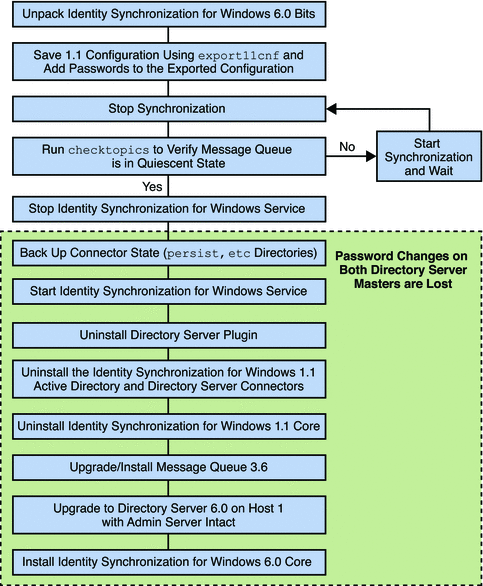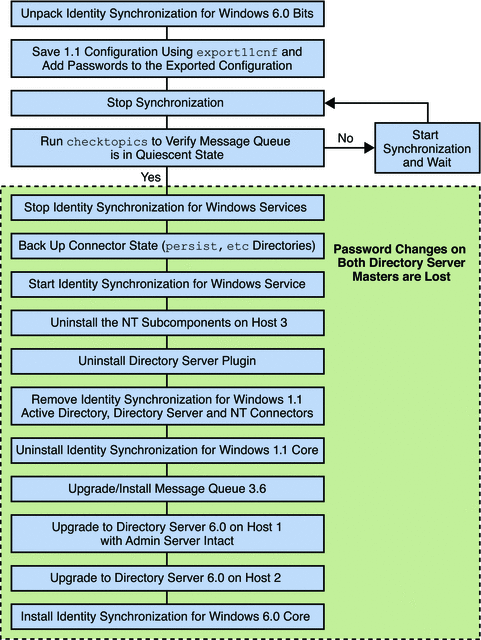Other Migration Scenarios
Because other deployment topologies are possible, your migration process may differ from the process described for a single-host deployment.
This section describes two alternative deployment scenarios and explains how to migrate in each case.
The sample deployment scenarios include:
Multi-Master Replication Deployment
In a multi-master replication (MMR) deployment, two Directory Server instances are installed on different hosts. It is possible to run the hosts on different operating systems, but in this scenario, both hosts are running on the same operating system.
Table 10–1 and Figure 10–2 illustrate how the Identity Synchronization for Windows components are distributed between the two hosts.
Table 10–1 Component Distribution in a Multi-Master Replication Deployment
The migration process keeps on-demand password synchronization running continuously on the preferred master or on the secondary master.
Note –
If both hosts are running on a Solaris operating system, then a third host running Windows 2000 with Active Directory is required for synchronization purposes only. (No components would be installed on the third host.)
The following figure illustrates the process for migrating Identity Synchronization for Windows in a MMR deployment.
Figure 10–2 Migrating a Multi-Master Replication Deployment

Multi-Host Deployment with Windows NT
Three hosts are used in this deployment scenario:
-
A Windows NT system
-
A host for Directory Server with the synchronized users and the Directory Server Connector
-
A host for all other components
Table 10–2 and Figure 10–3 illustrate how the Identity Synchronization for Windows components are distributed between the three hosts.
Table 10–2 Multi-Host Deployment
In the previous scenario, hosts 1 and 2 are running on the same operating system.
Note –
Directory Server at host1 contains the configuration registry and the Admin Server console. Ensure you migrate to Directory Server 11g Release 1 (11.1.1) using the -N option to keep the Admin Server intact. For more information on migrating configuration data and user data, see Using dsmig to Migrate Configuration Data and Using dsmig to Migrate User Data respectively.
Directory Server at host2 contains the data and the Directory Server plugin. When you migrate Directory Server to 11g Release 1 (11.1.1), the plugin configuration is lost. But it does not cause any problem as Identity Synchronization for Windows migration requires the connectors to be reinstalled and plugin to be reconfigured. Therefore, Directory Server at host2 should be migrated after Identity Synchronization for Windows uninstallation.
If both hosts are running a Solaris operating system, then a fourth host running Windows 2000 with Active Directory is required for synchronization purposes only. (No components would be installed on the fourth host.)
Figure 10–3 illustrates the process for migrating Identity Synchronization for Windows for a multi-host deployment
Figure 10–3 Migrating a Multi-Host Deployment with Windows NT

- © 2010, Oracle Corporation and/or its affiliates
